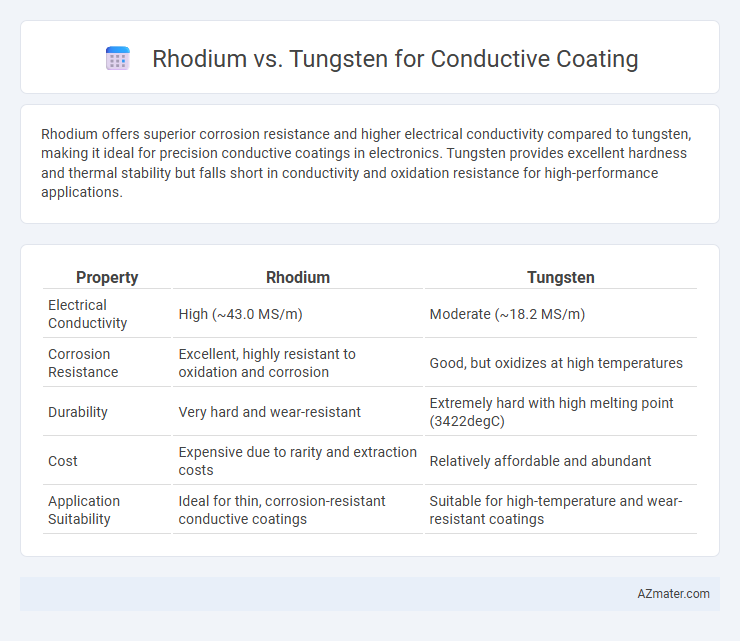Rhodium offers superior corrosion resistance and higher electrical conductivity compared to tungsten, making it ideal for precision conductive coatings in electronics. Tungsten provides excellent hardness and thermal stability but falls short in conductivity and oxidation resistance for high-performance applications.
Table of Comparison
| Property | Rhodium | Tungsten |
|---|---|---|
| Electrical Conductivity | High (~43.0 MS/m) | Moderate (~18.2 MS/m) |
| Corrosion Resistance | Excellent, highly resistant to oxidation and corrosion | Good, but oxidizes at high temperatures |
| Durability | Very hard and wear-resistant | Extremely hard with high melting point (3422degC) |
| Cost | Expensive due to rarity and extraction costs | Relatively affordable and abundant |
| Application Suitability | Ideal for thin, corrosion-resistant conductive coatings | Suitable for high-temperature and wear-resistant coatings |
Introduction to Conductive Coatings
Conductive coatings enhance electrical conductivity and protect surfaces from corrosion, with rhodium and tungsten being prominent materials in this application. Rhodium offers exceptional corrosion resistance and superior reflectivity, making it ideal for high-performance electronic contacts and connectors. Tungsten provides excellent hardness and thermal stability, suitable for environments requiring durability and sustained conductivity under extreme conditions.
Overview of Rhodium and Tungsten
Rhodium, a rare platinum-group metal, offers exceptional corrosion resistance and superior electrical conductivity, making it ideal for high-performance conductive coatings in electronics and jewelry. Tungsten, known for its remarkable hardness, high melting point, and good conductivity, is commonly used in industrial applications requiring durable and heat-resistant coatings. Both metals provide distinct advantages for conductive coatings, with rhodium favored for its corrosion resistance and tungsten valued for its mechanical strength and thermal stability.
Electrical Conductivity Comparison
Rhodium exhibits superior electrical conductivity compared to tungsten, making it a preferred choice for conductive coatings in high-performance electronic applications. With an electrical conductivity of approximately 21.6 million S/m, rhodium enables efficient current flow and minimal resistance. Tungsten, while highly durable and with a conductivity around 18 million S/m, tends to underperform relative to rhodium in scenarios demanding maximum electrical efficiency.
Corrosion and Oxidation Resistance
Rhodium offers superior corrosion and oxidation resistance compared to tungsten, making it highly effective for conductive coatings in harsh environments. Tungsten, while possessing excellent thermal stability and conductivity, tends to oxidize at elevated temperatures, leading to performance degradation over time. Rhodium's inertness to oxidation ensures sustained conductivity and longevity in applications requiring durable protective coatings.
Durability and Longevity
Rhodium offers superior corrosion resistance and maintains conductivity over extended periods, making it highly durable for conductive coatings in harsh environments. Tungsten, known for its exceptional hardness and high melting point, provides robust wear resistance but can oxidize more easily, potentially reducing longevity in certain applications. When balancing durability and longevity, rhodium's ability to resist tarnishing and maintain low electrical resistance often makes it the preferred choice for high-performance conductive coatings.
Cost and Availability Factors
Rhodium is significantly more expensive than tungsten due to its rarity and complex extraction process, which impacts its cost-effectiveness for conductive coatings. Tungsten offers greater availability and lower cost, making it a practical alternative for industrial applications that require durable and conductive surface layers. Cost-sensitive projects favor tungsten coatings, while rhodium is chosen for high-performance uses where superior conductivity and corrosion resistance justify the premium price.
Application Methods for Coating
Rhodium coatings for conductive applications are typically applied through electroplating, offering superior corrosion resistance and excellent conductivity ideal for high-precision electronic contacts. Tungsten coatings are commonly deposited using physical vapor deposition (PVD) or chemical vapor deposition (CVD), providing robust wear resistance suitable for high-temperature and abrasive environments. The choice between electroplated rhodium and PVD/CVD tungsten depends on the specific application requirements, with rhodium favored for fine electrical conductivity and tungsten preferred for durability and thermal stability.
Industrial and Commercial Uses
Rhodium offers superior corrosion resistance and higher reflectivity, making it ideal for industrial applications requiring durable, low-resistance conductive coatings in electronics and automotive components. Tungsten provides excellent thermal and electrical conductivity combined with high hardness, suited for commercial uses such as in heat sinks and electrical contacts where wear resistance is critical. The choice between rhodium and tungsten depends on balancing factors like conductivity, cost, and mechanical durability in specific industrial or commercial environments.
Environmental and Safety Considerations
Rhodium offers superior corrosion resistance and non-toxicity, making it environmentally safer than tungsten for conductive coatings. Tungsten's potential for dust inhalation and heavy metal toxicity raises significant safety concerns during manufacturing and disposal processes. Proper handling and recycling protocols are essential to mitigate environmental impact in both materials, but rhodium's inert nature results in fewer hazardous byproducts.
Choosing the Right Metal for Conductive Coating
Rhodium offers superior corrosion resistance and higher electrical conductivity compared to tungsten, making it ideal for precision electronic connectors and high-frequency applications. Tungsten provides exceptional hardness and wear resistance, which benefits conductive coatings subjected to harsh mechanical stress or elevated temperatures. Selecting between rhodium and tungsten for conductive coatings depends on balancing the need for electrical performance with mechanical durability and environmental stability in the target application.

Infographic: Rhodium vs Tungsten for Conductive Coating
 azmater.com
azmater.com